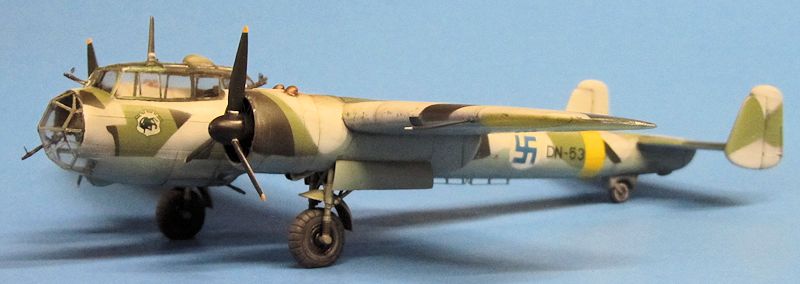
| KIT #: | 40417 |
| PRICE: | $12.00 twenty years ago |
| DECALS: | Two options |
| REVIEWER: | Ryan Grosswiler |
| NOTES: |
Frog main parts. Monogram detail parts. Lots of aftermarket. Lots of
work. And all just in time for that beautiful new Airfix kit! |

| HISTORY |
In 1981’s Raiders of the Lost Ark, there’s a memorable scene in which Evil Bad
Guy Archeologist René Belloq, ready to seal hero Indiana Jones plus girlfriend
in an ancient tomb, holds up a common
pocket-watch at him: “Look at this…it’s worthless. Ten dollars from a vendor on
the street. But I take it, I bury it in the sand for a thousand years; it
becomes priceless.” And just before the lid is slid shut, he taunts, “Who knows?
In a thousand years, even
you might
be worth something!”
In a much similar fashion, Dornier Do-17Z
Werknummer #1160 became just such a
priceless object when it broke the surface of the English Channel in the early
summer of 2013, raised by the Royal Air Force
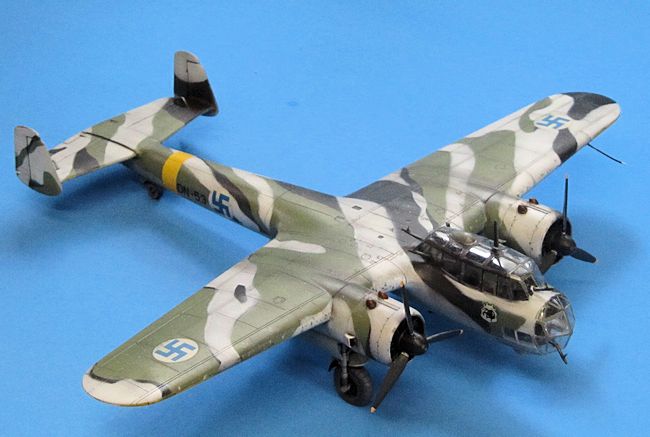 Museum from the shallow Goodwin
Sands off the extreme southeastern coast of England. Simply another ‘grunt’
Luftwaffe bomber shot down into the ocean by angry swarms of RAF fighters during
the Battle of Britain some 73 years prior, the RAFM has very tenderly recovered
the badly-corroded but 90% complete aircraft, and the ongoing— and
expert—conservation efforts for what Mark Twain would have referred to as
“remainders” is testament to the fact that this is the last specimen of one of
the most important aircraft from the early years of WWII. It makes for
fascinating perusal, and if you’re not familiar with these goings-on I highly
recommend you type something like “Dornier Recovery UK” or similar into your
search engine.
Museum from the shallow Goodwin
Sands off the extreme southeastern coast of England. Simply another ‘grunt’
Luftwaffe bomber shot down into the ocean by angry swarms of RAF fighters during
the Battle of Britain some 73 years prior, the RAFM has very tenderly recovered
the badly-corroded but 90% complete aircraft, and the ongoing— and
expert—conservation efforts for what Mark Twain would have referred to as
“remainders” is testament to the fact that this is the last specimen of one of
the most important aircraft from the early years of WWII. It makes for
fascinating perusal, and if you’re not familiar with these goings-on I highly
recommend you type something like “Dornier Recovery UK” or similar into your
search engine.
Unlike other German aircraft of this period, the Do-17 did not start life as a
concealed military project but legitimately as a high-speed 6-seat
airliner/cargo plane to fulfill a 1934 requirement. While it was truly fast for
the time, passengers did not like the 55”-high interior space and Deutsche Luft
Hansa did not like the maintenance costs of two engines. Heinkel’s competing
single engine He-70 was the winner. The three prototypes hung about the Dornier
factory idle for a year or so until a Luft Hansa captain happened by the
facility and decided to give one of them a test hop. His glowing report and
recommendation that the design be redeveloped as a bomber was forwarded to the
Air Ministry in Berlin. Shortly afterward and now sprouting guns, twin tails, a
bomb bay where the passengers were supposed to go, and a clear nose for the
bombardier, the airliner debuted in its new guise as a combat machine at the
1937 International Military Aircraft Competition held in Zurich. There it caused
a stir by thoroughly outclassing the French Dewoitine D.510, at that time
considered the best fighter in Europe: a bomber outperforming a fighter!
Simultaneously sent straight to the bloody civil war raging in Spain, it arrived
there as the Do-17E bomber and -17F reconnaissance plane, and in a twist of
irony replaced the competing He-70 which had in the meantime also been pressed
into military service. The slender plane soon garnered the nickname
Das Fliegender
Bleistift: The Flying Pencil.
Reality doing what it does to theory, the Spanish adventure soon exposed
weaknesses in the airliner-turned-bomber: by surprise the Soviet’s potent and
previously-ignored Polikarpov I-16 fighter was met in combat, a huge leap ahead
in offensive punch from that wispy French Dewoitine previously thought to
represent the state-of-the-art. The Dornier was now a tad slow and weakly
defended. 750 HP BMW in-line engines
were swapped for a pair of 1000 HP radials from the same firm, and the sleek
nose and cockpit were redesigned and ‘deepened’ to accommodate a new 4th
crewmember: a gunner firing his
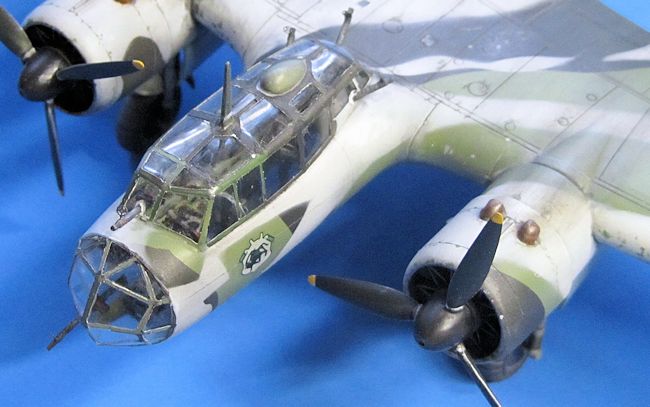 weapon below and aft to cover the bomber’s
vulnerable belly. The new, angular, and rather ugly front end closely grouped
the entire crew together for communications and morale and caused the airplane
to lose its svelte “flying pencil” look.
weapon below and aft to cover the bomber’s
vulnerable belly. The new, angular, and rather ugly front end closely grouped
the entire crew together for communications and morale and caused the airplane
to lose its svelte “flying pencil” look.
This final, main version went into service in 1939 as the Do-17 ”Z”, and owing
to Germany’s exponential industrial ramp-up in preparation to (essentially)
invade the world, very quickly supplanted earlier versions of the plane in
first-line combat units. Its first sortie was launched 45 minutes after the
outbreak of WWII on 1 September 1939 and (alongside Heinkel’s sinister He-111)
was the main bombardment aircraft in every single Blitzkrieg campaign except the
invasion of Norway. However, while popular with both air and ground crews for
its good handling and reliability, the more skeptical eyes of the Luftwaffe’s
strategic bean-counters could only note that it lacked both the load-carrying
capability of the He-111 and the speed and adaptability of another aircraft,
Junkers’ wondrous new Ju-88, which was just starting to enter service. After all
this work, doomed by the lack of growth potential, the Dornier Do-17 departed
Luftwaffe service rapidly after the invasion of the USSR in June 1941, replaced
by Dornier’s own and far more up-to-the-task Do-217
for the rest of the war, passing on to secondary roles and to Germany’s allies,
notably Hungary, Croatia, and Finland.
Already a fairly pro-German state, the Finns had gambled that, by allying
themselves with Germany for the invasion of Russia, they could regain
territories lost in the unprovoked Soviet attack eighteen months earlier, and
the 15 Dorniers provided by Germany supplemented their overused Bristol
Blenheims and nearly doubled the power of their bomber force upon arrival. These
were in service for a couple of years before being relegated to mapping duties,
replaced again by that ubiquitous Ju-88. This tiny force achieved results far
out of proportion to its numbers with raids on Soviet airfields and supply
lines, helping the Finns hold their frontier (to its credit, Finland advanced
only to its old border—no further) until the gamble turned into a bust at the
end of 1944 and the ceded borders were affirmed with the Soviets after all.
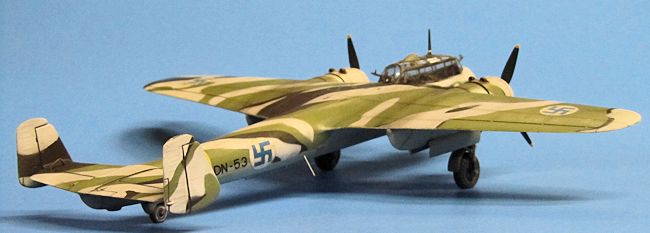 As for the German ‘17s, a dependable airplane is a dependable airplane, and all
variants would continue doing various rear-echelon jobs throughout the war, the
“Zs” making one final appearance tugging gliders to supply the desperate
defenders of Budapest in early 1945. Of absolutely zero technical interest to
the victorious Allies, none were consciously preserved for posterity, with the
Finns scrapping the last of theirs in the early 50s to comply with postwar
treaties forbidding that nation to possess aircraft with an internal bomb bay.
As for the German ‘17s, a dependable airplane is a dependable airplane, and all
variants would continue doing various rear-echelon jobs throughout the war, the
“Zs” making one final appearance tugging gliders to supply the desperate
defenders of Budapest in early 1945. Of absolutely zero technical interest to
the victorious Allies, none were consciously preserved for posterity, with the
Finns scrapping the last of theirs in the early 50s to comply with postwar
treaties forbidding that nation to possess aircraft with an internal bomb bay.
By this sequence, it falls on an innocuous set of remains and a very dedicated
team of experts to see that a notable aircraft type will not fall into oblivion.
Serendipitously, the fact that much of this aircraft’s skin has dissolved in the
salt water has inadvertently made it an intriguing cut-away display, revealing
interesting and otherwise-invisible interior details.
| THE KIT |
While the 1/48 community has been provided with the
Hobbycraft kit with its banana-shaped
fuselage and the far better
Classic
Airframes release, and the 1/72 crowd has had a variety of the early
versions from RS,
Airfix, and
ICM, a definitive kit of the main “Z”
version has been oddly lacking.
Frog
released one in the early 1960s (available for the vast majority of its 40-year
production life under the
Revell-Germany
label and briefly in the 90s under
Matchbox) and
Monogram another
about 1968. Therefore, your choice was this: The crude but accurate Frog kit, or
the far crisper and better-detailed
Monogram kit which nonetheless was cursed with a wing far too broad in
chord. Therefore, for decades, the standard procedure to get your “Z” was to
start with the Frog kit and give it more alterations than an
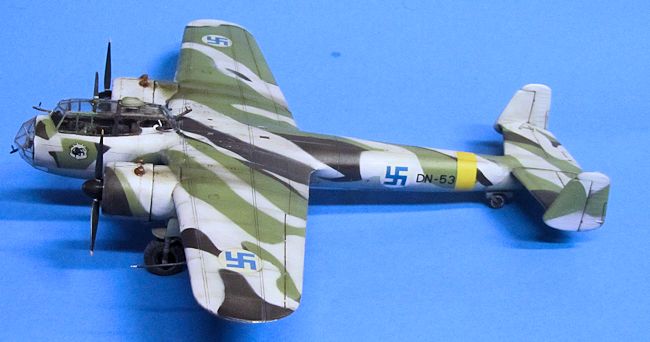 aging spinster
heiress. Ray Rimmel, known more for his extensive work in Great War modelling
and documentation, wrote an article back in the 80s for
Scale Models magazine detailing his
process doing so (as part of a series, and it was reproduced in book form in
1990 entitled Modelling Battle of Britain
Aircraft and included lots of useful artwork and documentation). I used this
as my starting point, taking it quite a bit further.
aging spinster
heiress. Ray Rimmel, known more for his extensive work in Great War modelling
and documentation, wrote an article back in the 80s for
Scale Models magazine detailing his
process doing so (as part of a series, and it was reproduced in book form in
1990 entitled Modelling Battle of Britain
Aircraft and included lots of useful artwork and documentation). I used this
as my starting point, taking it quite a bit further.
(Side-bar note: this wasn’t my first experience with this kit. Sometime in the
late ‘70s, Todd and Jeff, twin teenage-surfer neighbor boys and United Airlines
brats like me, brought themselves with their blond-mushroom hair over to kid-sit
my seven-year-old self one evening while the rest of my family was out—and this
kit along as entertainment. Though it was missing its nose piece, we built the
model over that evening, and they resourcefully replaced the missing clear part
with the excess forward turret left over from Revell’s Jacques Cousteau PBY
Catalina. “This’ll keep the wind off the
pilot’s face, man” said one of them [“dude” wasn’t a part of the lingo yet].
Though they departed telling me this was just a fun model and I was free to
throw it around or let Duchess the Terrier chew it up, it in reality builds into
such a durable model that I think it’s still intact somewhere in my parents’
attic.)
As implied, this is a very involved undertaking and I took it on an overseas deployment as a time-killer. My planned parts breakdown ended up as follows: fuselage, wing, engine nacelles and cowlings: Frog. Tail surfaces, landing gear w/ doors, engine faces, propellers, ventral gunner’s canopy, and other small bits: Monogram. Cockpit detail: Eduard photoetch (intended for the Monogram kit) and scratch. Canopies: Falcon. MG-15 guns: Aeroclub. Wheels: True Details (re-inflated).
| CONSTRUCTION |
Modelers of the Do-17 will note that you needn’t do any work on the cockpit
until the airframe is all assembled, such is the accessibility provided by that
nose and massive greenhouse canopy. There are lots of delicate do-dads in the
cockpit vulnerable to breakage during the gross filling and sanding
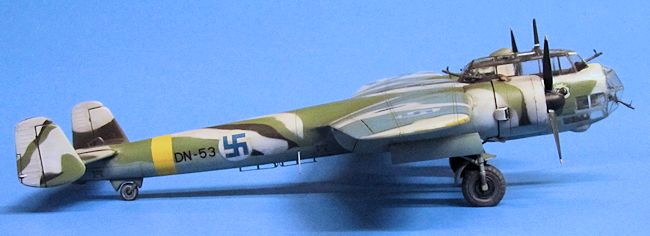 operations
which lay ahead and it’s best to leave the cockpit out until all this is done.
operations
which lay ahead and it’s best to leave the cockpit out until all this is done.
Accordingly, I began work by cutting and installing the bomb bay skylights, then
followed by main airframe assembly and grafting the Monogram tail and gunner’s
glazing to the Frog airframe with lots of sawing, grinding, and epoxy putty. All
gaps (including ailerons) were filled and a comprehensive general sanding
followed (the delicate raised detail on the Monogram tail was masked and
retained) to give me a smooth surface. The second phase involved re-scribing the
lost detail and I used various 3-view drawings found online for reference in
this. Monogram engine faces were glued in the place of the sliced-off Frog
cowling lips, though they’re a tad shallow upon reflection.
The local Afghanis, hired for sentry work (!) and other menial jobs on my
forward operating base, would gather to patiently watch me doing all this in the
USO club, sometimes for hours. The sight of a Western person spending such time
on handicraft was unfamiliar to them, and some of the English-speaking ones
possessed a surprising knowledge of World War II history (finding something to
eat and a little safety is a more pressing concern there--not to mention the
decades-long lack of a functional public education system) and understood the
context of the object concerned. “Yes, a German airplane” said o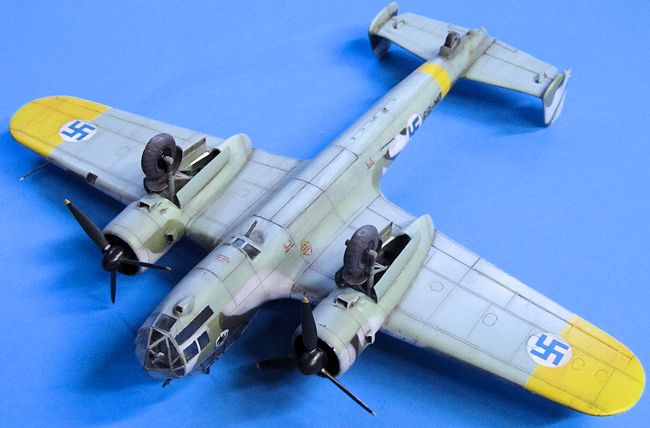 ne of them,
sitting with legs pulled up under his long
kameez tunic, “made to fight
England!”
ne of them,
sitting with legs pulled up under his long
kameez tunic, “made to fight
England!”
My attention turned finally to the cockpit. The Eduard photoetch parts, intended for the Monogram kit, were adapted to the very different Frog fuselage and supplemented with some scratch building and white metal MG-15 machine guns from my dwindling supply of Aeroclub bits. I spent a lot of time not only painting the RLM 02 Grau but with highlights and shadows, as this is one cockpit that remains pretty visible in normal light on the completed model. It was all then closed up under those jewel-like Falcon vac-form canopies, masked over several sessions with Tamiya tape. Antennas, pitot tube, and elevator mass balances were then attached and it was packed in my duffel for home and the paint shop.
| COLORS & MARKINGS |
I found out about the imminent availability of the all-new (and
impressive-looking) New Airfix kit about this time, so I moved into high gear to
get this stinker finished. After all the work, I wanted to do something
different than the same ‘ol three-tone German splinter scheme, and thus selected
the hideous Finnish winter camouflage depicted. A mix of Testors and Xtracolor
paints—and about 8 hours of total masking (and 20 minutes of airbrushing) with
more Tamiya tape yielded it. That elusive Finnish hue of green was represented
by an approximate 50/50 mix RAF Dark Earth and RLM 83 Lichtgrun, also from
dwindling supplies, with a little white for scale effect.
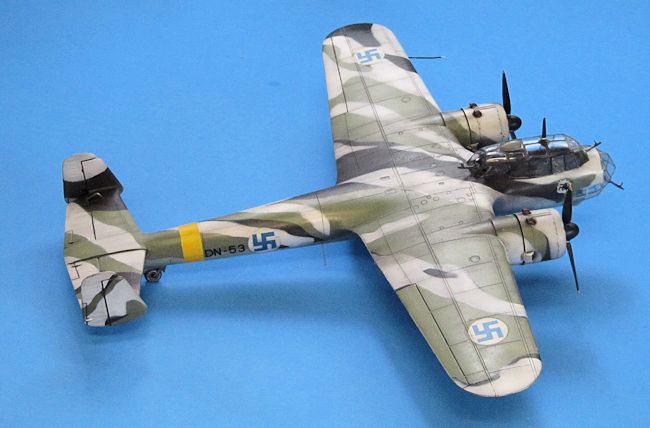 Decals came from a variety of sources, all over twenty years old—Monogram for
the technical stencils on the lower surfaces (Photographic evidence confirms
this for Finnish use, but I couldn’t find a clear upper-surface shot of a
Finnish machine so I left them off up top), Tally-ho (the old Canadian firm) for
the individual aircraft markings, and Aviation Usk for the national markings.
Modelers wanting to ‘do’ this aircraft will note that decals for this scheme are
available at this writing from both the Polish firm Techmod as product #72136
and the UK’s Xtradecal as #72206.
Decals came from a variety of sources, all over twenty years old—Monogram for
the technical stencils on the lower surfaces (Photographic evidence confirms
this for Finnish use, but I couldn’t find a clear upper-surface shot of a
Finnish machine so I left them off up top), Tally-ho (the old Canadian firm) for
the individual aircraft markings, and Aviation Usk for the national markings.
Modelers wanting to ‘do’ this aircraft will note that decals for this scheme are
available at this writing from both the Polish firm Techmod as product #72136
and the UK’s Xtradecal as #72206.
Finnish use of the swastika as national
identity for their military aircraft dates back to 1919 when a Swedish nobleman,
who used it as a personal emblem, gifted the Finnish air force its first
aircraft and the Finns used this marking in their national colors as a gesture
of gratitude. About the same time, an angry former German Air Service officer by
the name of Herman Goering, finding itinerant charter pilot work in the area,
showed up at this same nobleman’s home and became infatuated with the man’s
sister-in-law, Carin von Kantzow—later to be Goering’s famous, grieved wife. The
story goes that he also first noted the swastika on this visit and suggested it
to another disgruntled Great War veteran buddy of his who was busy starting a
violent, radical ultranationalist political party in Bavaria. The timing is off
by a couple of years for this last to likely be true, but the minor crossing
point of history is nonetheless fascinating.
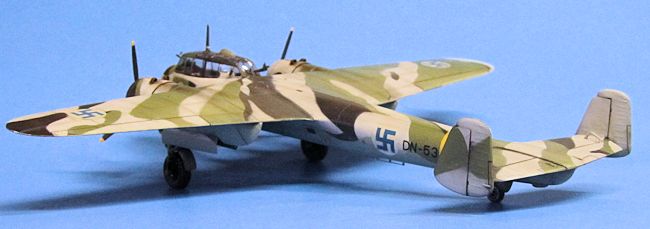 Paint and decals were sealed in with Future floor coating. A wash was applied
with some thinned Testor’s enamels to all panel lines, allowed to dry for a few
hours, the excess then wicked away in the direction of airflow with some
denatured alcohol on Q-tips. I find this represents well the subtle overall
‘grub’ carried by all working aircraft. This was supplemented with some mixed
pastels sanded to powder and brushed on for the exhaust smudges, and a light
Testor’s Metallizer Aluminum dry-brushing to accentuate some prominent edges.
All was locked in under a coat of Aeromaster semi-gloss clear enamel…haven’t
found an adequate replacement for this product yet. Landing gear and doors were
attached and she was off the bench and on to the dining room table, to my
family’s bemusment.
Paint and decals were sealed in with Future floor coating. A wash was applied
with some thinned Testor’s enamels to all panel lines, allowed to dry for a few
hours, the excess then wicked away in the direction of airflow with some
denatured alcohol on Q-tips. I find this represents well the subtle overall
‘grub’ carried by all working aircraft. This was supplemented with some mixed
pastels sanded to powder and brushed on for the exhaust smudges, and a light
Testor’s Metallizer Aluminum dry-brushing to accentuate some prominent edges.
All was locked in under a coat of Aeromaster semi-gloss clear enamel…haven’t
found an adequate replacement for this product yet. Landing gear and doors were
attached and she was off the bench and on to the dining room table, to my
family’s bemusment.
| CONCLUSIONS |
I’m generally pleased with the result. But I don’t recommend you go about things
this way at all to get that 1/72 Dornier in your lineup. Keep a crystal ball or
some other kind of clairvoyant device handy so when a newly-resurgent legacy
model kit company starts thinking about cutting molds for a long-neglected
subject you can save yourself a whole lot of trouble and go their route!
| REFERENCES |
Gunston, Bill.
Classic
Aircraft Cutaways. 1995
Rimmel, Ray. Modelling Battle of Britain Aircraft. 1982 and 1990
Keskinen and Stenman. Finnish Air Force 1939-1945. 1998
Green, William. Warplanes of the Third Reich. 1970
Taylor, William. Combat Aircraft of the World. 1969
January
2015 If you would like your product reviewed fairly and fairly quickly, please
contact
the editor or see other details in the
Note to
Contributors.